This whole thing came about because i am creating an MVC framework that utilizes a generic Class constructor. I ran these variations in the larger context of the Class constructor with two different implementation methods. Method 1 reassigns the prototype where method 2 extends it. Method 1 has a uniform prototype chain where method 2 adds a function prototype on top of the object prototype for syntax #1. The performance is about equal for both method 1 and 2.
Blue & Red = syntax #1.
Teal & Green = syntax #2.
Yellow & purple = a variation on syntax #2.

var Class = function (methods, options) {
//allow for Proper class name to show up in browser devtools
options = options || {}
var debug = options.debug || false
var protoTest = options.protoTest || 0
var pInternal = options.pInternal || true
var klassName = methods.constructor.name
console.log('------protoTest =', protoTest, '/ debugClass =', debug, '/ pInternal =', pInternal, '/ klassName = ',klassName)
//compile the constructor & internalMembers
var Class = function () {
//console.log('Class() is building:', !(init instanceof init))
//provide inernal object for constructor
if (pInternal) this.internal = {}
this.constructor.apply(this, arguments);
//remove internal from public scope
if (pInternal){
var int = this.internal
delete this.internal
}
//populate self with this and internal vars
if (pInternal){
var self = {pub:this, int:{}};
for (var v in int){
self.int[v] = int[v];
}
}else var self = this
// Instantiate internalMembers with self
var include = methods.include;
if (include) include.call(this, self);
};
//create constructor function with className (fixes class name in debugger)
if (debug == true && klassName) {
var klass = new Function("init", "return function " + klassName + "(){ init.apply(this,arguments) };")(Class);
}else var klass = Class
console.log('---type', typeof methods.prototype)
if (typeof methods.prototype == 'object'){
//must use traditional revealing prototype
var prototype = methods.prototype;
if (protoTest==0){
//overides prototype
if (prototype) klass.prototype = prototype;
}else{
//does not overide prototype
for (var p in prototype) klass.prototype[p] = prototype[p]
}
}
//create prototype from Class method
//----------------test 0
else if (protoTest==0){
//overides prototype (new has extra proto in chain)
var prototype = methods.prototype;
if (prototype) klass.prototype = new prototype();
}
//----------------test 1
else if (protoTest == 1){
//does not overide prototype and has uniform chain
var pms = new methods.prototype()
for (var p in pms) klass.prototype[p] = pms[p]
}
//----------------end test
//add other Class methods to prototype
var exclude = ['include', 'initialize', 'prototype'];
for (var property in methods) {
if (exclude.indexOf(property) == -1) {
klass.prototype[property] = methods[property];
}
}
return klass; //return the class
};
All the tests: http://jsperf.com/revealing-proto-test/4
The fiddle: http://jsfiddle.net/arctelix/Cp4nG/
There is a debug mode with tests as well: http://jsperf.com/revealing-proto-test/3
